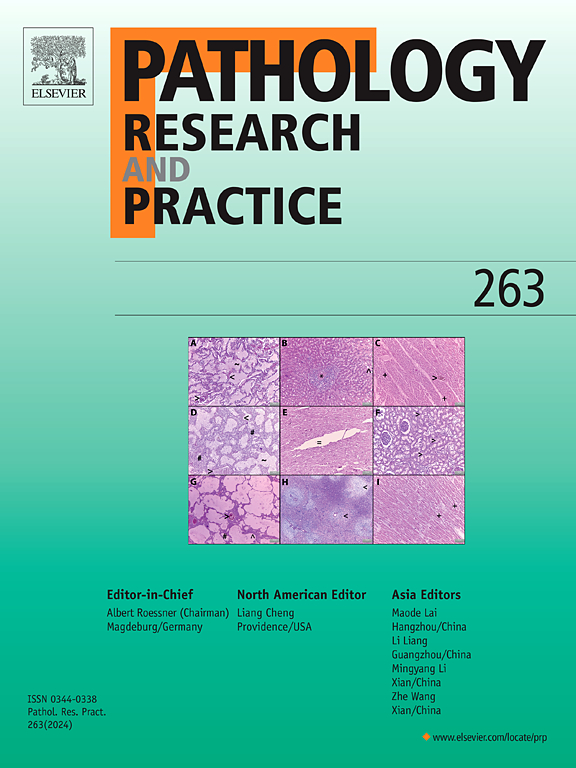人类肿瘤中 PGP9.5 的表达:对来自 120 个不同肿瘤实体的 13 920 个肿瘤进行的组织芯片研究。
IF 2.9
4区 医学
Q2 PATHOLOGY
引用次数: 0
摘要
蛋白基因产物 9.5(PGP9.5)又称泛素 C 端水解酶 L1(UCH-L1),是泛素化/去泛素化系统的重要组成部分,在轴突运输中发挥作用。为了全面确定 PGP9.5 在肿瘤组织中的表达,我们通过免疫组织化学(IHC)分析了一个包含 13,920 个样本的组织芯片,这些样本来自 120 种不同的肿瘤类型和亚型。在 120 个肿瘤类别中的 109 个中发现了 PGP9.5 免疫染色,其中 87 个至少有一个强阳性病例。PGP9.5 阳性最多见于神经元和神经内分泌肿瘤(50%-100%)、生殖细胞肿瘤(28%-84%)、肉瘤和癌肉瘤(高达 91%)以及间皮瘤(58%-83%)。在透明细胞 RCC(肾细胞癌)中,PGP9.5 的强染色与 ISUP(国际泌尿病理学会)的高分级相关(p<0.05)。本文章由计算机程序翻译,如有差异,请以英文原文为准。
PGP9.5 expression in human tumors: A tissue microarray study on 13,920 tumors from 120 different tumor entities
The protein gene product 9.5 (PGP9.5), also termed ubiquitin C-terminal hydrolase L1 (UCH-L1) is an important component of the ubiquitination/deubiquitination system and plays a role in axonal transport. To comprehensively determine PGP9.5 expression in neoplastic tissues, a tissue microarray containing 13,920 samples from 120 different tumor types and subtypes was analyzed by immunohistochemistry (IHC). PGP9.5 immunostaining was found in 109 of 120 tumor categories, 87 of which contained at least one strongly positive case. PGP9.5 positivity was most seen in neuronal and neuroendocrine neoplasms (50–100 %), germ cell neoplasms (28–84 %), sarcomas and carcinosarcomas (up to 91 %), and in mesotheliomas (58–83 %). In clear cell RCC (renal cell carcinomas), strong PGP9.5 staining was associated with high ISUP (International Society of Urological Pathology) grade (p<0.0001), advanced pT stage (p=0.0003), nodal (p=0.0242) and distant metastasis (p<0.0001) as well as with a short overall, tumor specific and recurrence free survival (p≤0.0007 each). In papillary RCC, strong PGP9.5 staining was associated with high ISUP grade (p=0.009) and reduced recurrence free survival (p=0.0221). In urothelial carcinoma of the urinary bladder, high PGP9.5 expression was associated with muscle-invasion (p<0.0001). PGP9.5 immunostaining was unrelated to histological parameters for tumor aggressiveness in 295 serous high-grade ovarian carcinomas, 174 endometrioid endometrium carcinomas, 292 papillary and 89 follicular thyroid carcinomas, 405 ductal adenocarcinomas of the pancreas and in 327 gastric adenocarcinomas. In summary, our data provide a comprehensive overview of PGP9.5 expression in cancer and demonstrate positive cases in a broad range of entities. PGP9.5 overexpression is linked to patient outcome in some tumor entities (i.e., clear cell RCC) but appears to be unrelated to clinically relevant tumor characteristics in many other frequent tumor entities.
求助全文
通过发布文献求助,成功后即可免费获取论文全文。
去求助
来源期刊
CiteScore
5.00
自引率
3.60%
发文量
405
审稿时长
24 days
期刊介绍:
Pathology, Research and Practice provides accessible coverage of the most recent developments across the entire field of pathology: Reviews focus on recent progress in pathology, while Comments look at interesting current problems and at hypotheses for future developments in pathology. Original Papers present novel findings on all aspects of general, anatomic and molecular pathology. Rapid Communications inform readers on preliminary findings that may be relevant for further studies and need to be communicated quickly. Teaching Cases look at new aspects or special diagnostic problems of diseases and at case reports relevant for the pathologist''s practice.

 求助内容:
求助内容: 应助结果提醒方式:
应助结果提醒方式:


